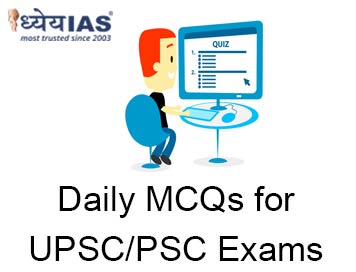Home > Daily-mcqs
Daily-mcqs 22 Nov 2025

Q1:
With reference to the India Justice Report’s (IJR) study on “Juvenile Justice and Children in Conflict with the Law”, consider the following statements: 1. Over half of all cases before Juvenile Justice Boards (JJBs) in India remained pending as of October 2023. 2. Nearly one-third of all JJBs in the country function without a full bench. 3. All states and Union Territories in India have at least one “place of safety” for children aged 16–18 accused of heinous offences. Which of the statements given above is/are correct?
A: 1 only
B: 2 only
C: 2 and 3 only
D: 1, 2, and 3
Answer: A
Explanation:
Statement 1 is correct.
The IJR study shows that 55% of the 1,00,904 cases before 362 JJBs were pending as of 31 October 2023. This indicates a high pendency rate and systemic delays in adjudication for children in conflict with the law.
Statement 2 is incorrect.
According to the report, nearly one-fourth of all JJBs in the country function without a full bench (which must include: principal magistrate + 2 social workers, one of whom must be a woman).
Statement 3 is incorrect.
The report highlights that 14 states and the Union Territory of Jammu & Kashmir lack any “place of safety” — institutions mandated for children aged 16–18 accused of heinous crimes. Thus, such facilities are not present in all states/UTs.
Q2:
With reference to the Juvenile Justice (Care and Protection of Children) Act, 2015, consider the following statements: 1. The Act allows juveniles aged 16–18, involved in heinous offences, to be tried as adults after assessment by the Juvenile Justice Board (JJB). 2. The 2015 Act completely replaces all previous personal laws on adoption, including the Hindu Adoptions and Maintenance Act, 1956. 3. The Act grants statutory status to the Central Adoption Resource Authority (CARA) to streamline adoption procedures. Which of the statements given above is/are correct?
A: 1 only
B: 1 and 3 only
C: 2 and 3 only
D: 1, 2, and 3
Answer: B
Explanation:
Statement 1 is correct.
The 2015 Act introduced the “judicial waiver system”, permitting juveniles aged 16–18 accused of heinous offences to be tried as adults, subject to an assessment by the Juvenile Justice Board (with psychologists and social workers).
Statement 2 is incorrect.
The Act does not replace personal laws like the Hindu Adoptions and Maintenance Act, 1956 or the Guardians and Wards Act, 1890.
It provides a universally accessible adoption law, but exists alongside personal laws, not in substitution.
Statement 3 is correct.
To streamline adoption, the Act gives statutory status to CARA, strengthening its powers.
Q3:
With reference to the 7th NSA-level Meeting of the Colombo Security Conclave (CSC) held in November 2025, consider the following statements: 1. The meeting was chaired by India’s National Security Adviser in New Delhi. 2. Seychelles participated as an observer state at CSC. 3. Malaysia attended the meeting for the first time as a guest country. Which of the statements given above is/are correct?
A: 1 and 2 only
B: 2 only
C: 1 and 3 only
D: 1, 2, and 3
Answer: C
Explanation:
Statement 1 is correct.
The 7th CSC meeting was hosted by India and chaired by NSA Ajit Doval in New Delhi, highlighting India’s centrality in the grouping.
Statement 2 is incorrect.
Seychelles had earlier participated as an observer, but at this 7th meeting it was formally welcomed as a full member of the CSC.
Statement 3 is correct.
Malaysia attended as a guest for the first time, indicating growing external interest in the CSC beyond the core Indian Ocean states.
Q4:
With reference to UNICEF’s State of the World’s Children 2025 report, consider the following statements: 1. Over 400 million children globally are “severely deprived” in at least two basic dimensions such as education, health, or sanitation. 2. The report defines extreme monetary poverty for children as living on less than US$ 3 a day. 3. The highest concentration of multidimensional child poverty is found in Latin America and Southeast Asia. Which of the statements given above is/are correct?
A: 1 and 2 only
B: 1 and 3 only
C: 2 and 3 only
D: 1, 2, and 3
Answer: A
Explanation:
Statement 1 is correct.
According to the UNICEF report, more than 417 million children (i.e., over 400 million) in low- and middle-income countries are severely deprived in at least two vital areas (education, health, housing, nutrition, sanitation, water).
Statement 2 is correct.
The report states that more than 19% of children globally live in extreme monetary poverty, defined as surviving on under US$ 3 per day.
Statement 3 is incorrect.
The report identifies the highest rates of multidimensional child poverty in Sub-Saharan Africa and South Asia, not Latin America and Southeast Asia.
Q5:
With reference to UNICEF, consider the following statements: 1. UNICEF was originally created in 1946 to provide relief to children affected by World War II. 2. UNICEF relies primarily on assessed contributions from UN member states for its funding. 3. UNICEF became a permanent part of the UN System in 1953. Which of the statements given above is/are correct?
A: 1 and 2 only
B: 1 and 3 only
C: 2 and 3 only
D: 1, 2, and 3
Answer: B
Explanation:
Statement 1 is correct.
UNICEF was created on 11 December 1946 by the UN Relief Rehabilitation Administration to provide emergency assistance to children and mothers affected by World War II.
Statement 2 is incorrect.
UNICEF is entirely funded by voluntary contributions, not mandatory assessed contributions.
Its funding comes from governments, NGOs, private donors, and corporate partnerships.
Statement 3 is correct.
In 1953, UNICEF became a permanent UN agency and its name changed to United Nations Children’s Fund.